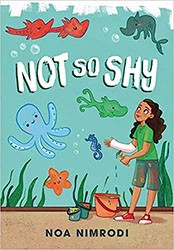Any seder might involve a few glitches, but imagine if a giant palm tree fell
across the road as you made your way to the celebration, blocking your path before you even had the chance to sit at the table. In Roadside Seder, a multicultural cast of characters en route to Jerusalem experience this unlikely obstacle. Together, Anna Levine’s lively text and Naama Lahav’s brightly colored illustrations tell a story about ingenuity and cooperation with surprising results.
The book begins with a typical complaint about the traffic; the illustration shows a long line of cars receding into the horizon. The scene shifts to the inside of a car, where parents, grandparents, and Benji, a boy dressed like Moses, are growing impatient. Soon the
scene expands to a cross-section of Israeli society. Sephardim and Ashkenazim, soldiers, members of the Orthodox community, young and old, are stranded by the toppled palm tree. Grandma calls the situation “a plague,” but whereas the Ten Plagues preceded the Israelites’ flight to freedom, the immovable tree has left everyone stuck where they are. Lahav’s pictures capture the frustration of the adults. Thent Benjy and a girl with a skateboard come up with a creative idea. They will hold the seder on the side of the road, setting the improvised palm-tree table with matzah, charoset, maror, and everything else needed for the ritual. A two- page spread shows this diverse group of Jews celebrating together.
The text combines rhymes and prose, with some sentences inside word bubbles and others formatted traditionally. This engaging presentation moves the narrative along to its core. The Jewish people, exemplified in the book’s characters, have many distinctive customs. An Ethiopian woman demonstrates the smashing of an old ceramic bowl before using a new one for the holiday. A Moroccan grandfather passes the seder plate over the head of each guest in a gesture of blessing. Persian participants are seen “bopping” spring onions over one another’s heads, in playful defiance of Pharaoh’s cruelty. Yet this colorful variety of traditions actually underscores the unity of the Jewish people. Together, under a road sign directing travelers towards an inaccessible Jerusalem, they cheerfully vary the ideal destination for Pesach, as Benjy enthusiastically calls for next year’s seder to be a roadside one.
This highly recommended picture book includes an afterword, a glossary, and a recipe for charoset.
Emily Schneider writes about literature, feminism, and culture for Tablet, The Forward, The Horn Book, and other publications, and writes about children’s books on her blog. She has a Ph.D. in Romance Languages and Literatures.





